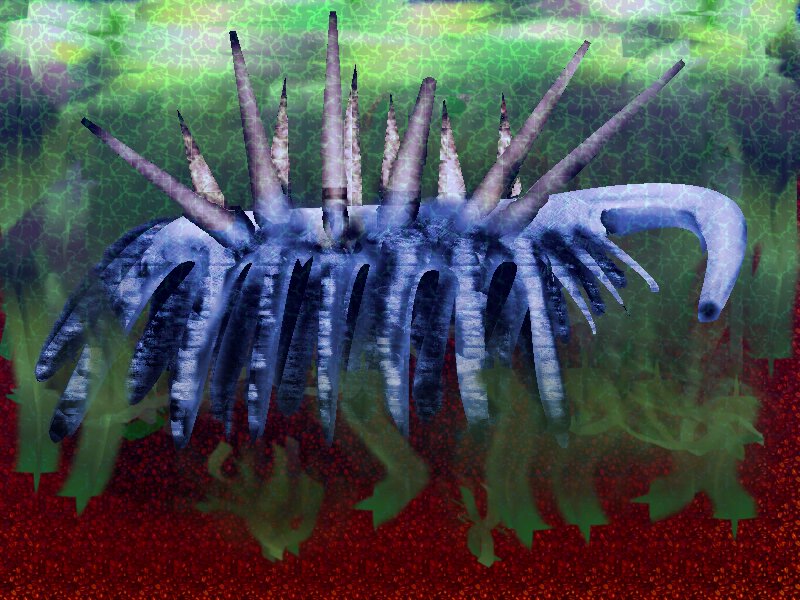Hallucigenia sparsa has found a home

Artists rendereing of Hallucigenia (Photo: Scorpion451 // CC-BY-SA-2.5. wikipedia: http://bit.ly/1wgt2hA)
When Charles Doolittle Walcott discovered the first Hallucigenia sparsa, a strange looking creature with lots of spikes and legs, he started a classification discussion that would last for more than 100 years. Until recently the bizarre fossil had not found it’s place in the evolutionary Tree of Life – nobody could tell what it actually was. As you can see on the picture above, the critter looks a lot like something you might find in your nightmares. And it’s looks are also the reason for Hallucigenias being used as the creature’s names. It’s said to be a reference to the “dreamlike” appearance of the species.
Creature from the abyss
Around 500 million years ago, the millipede-like creature with spikes lived during the Cambrian Explosion, a period in Earth’s history when most major animal phyla appeared in a relatively short amount of time. We are talking about a period of between five to 10 million years. Science has a lot of evidence in the form of fossils from this time.
The Hallucigenia were between five and 35 millimeters in length, and lived on the floor of the Cambrian oceans.
Finally the journey ends
So, now scientists of the University of Cambridge’s Department of Earth Sciences have finally classified Hallucigenia sparsa as an ancestor of the modern velvet worm. The research was published in the Aug. 17, 2014, issue of the journal Nature.
Eating our way through endangered species
Jennifer Seitz ponders humans’ seemingly insatiable appetite for exotic and wild meat – one that’s driving critically endangered species like the pangolin to the brink of extinction.
Man is the world’s most insatiable and efficient predator. His highly developed intelligence and the use of weapons and arms gives him the opportunity to kill opponents who normally would be much superior in the wild.
Furthermore, humans are ‘super-predators’ because they don’t just decide for one predator-prey system, but decide to get for all animals they feel threatened by. Although humans have managed to domesticate a lot of animals like cows, pigs and poultry they’re not satisfied with it. Nope. They also love to eat exotic animals. And they’re doing it in such a frenzied way that these animals are nearly extinct. That’s what happened to pangolins. Their meat is so highly coveted in China and Vietnam, that all eight pangolin species were upgraded on the IUCN Red List of Threatened Species. They’re critically endangered and the most illegally-traded mammals in the world – a sad record.
And because pangolins in Asia are becoming scarce, a booming pangolin trade in Africa has developed. Even there, the little scaly anteaters with their sticky tongues aren’t safe anymore.
But hey humans, don’t worry. When the pangolins have disappeared, there are still enough other endangered species which can be eaten to extinction.
More information can be found here.
I’ll scratch your back if you scratch mine
By Jennifer Seitz
It’s hard to be a wild animal. As if it wasn’t enough that their habitats are threatened and they are challenged by climate change, they are also besieged by humans equipped with cameras and spyglasses to watch their every little twitch.
“Enough with that!,” the Samango monkeys (Cercopithecus albogularis) in South Africa may have thought. ‘If you’re hanging out in our place, we might as well put you to good use and make you our bodyguards!’
Monkeys opting for a human security detail? Well, this is what a new scientific study published in the magazine Behavioral Ecology suggests. According to the study the monkeys use field researchers as human shields against predators. The researchers, headed by Katarzyna Nowak from Durham University have shown in an experiment that the monkeys felt much safer and stayed longer at their feeding sites when people were around.
The furry fellows are not only eating longer in the company of human onlookers, it has also made them change their snack locations. Like most of their colleagues Samango monkeys gobble up their food up in the trees where they are safe from ground-based predators. While observing trees, which had been prepared with feed buckets at different heights the researchers discovered that the monkeys enjoyed their meals closer to the ground than usual, because they seemed to feel even safer in the presence of the researchers.
Quite clever these little fur balls!
But Nowak and her team raised another serious point well beyond their clever monkeys. How accurate can behavioral studies with animals actually be when the mere presence of the researchers is enough to change their behavior
Who knows what’s going on in the forest when nobody is watching?!
Biodiversity for download

You may soon get some biodiversity for your PC and smartphone (Photo: wetwebwork on flickr, under CC BY-SA 2.0 license)
Biodiversity is good we are told. And that’s why it might be hitting your app store soon. While security software needs to constantly adapt to the latest internet scares, there has so far been no general way to counter viruses and malware messing up your smartphone. Now, scientists are looking to nature for help. Just as a population of species benefits from genetic variety to become more virus-resistant, so can software – in theory anyway.
But computer scientist Michael Franz has outlined how diversity can be introduced into software in an automated fashion and on a large scale. Ideally, this happens right at the source, such as in app stores for smartphones and tablets.
“The point of our solution is that the app store generates the versions,” we were told by Franz, who is a professor at the University of California at Irvine. In current app store models such as for iOS, Android, or MacOSX – downloaded software is uniquely tied to a user via a user ID, he explains. “From here, it is only a small step to use and authenticate different [software versions] for each user.”
The idea is that if a virus needs to adapt to millions of slightly different versions of what is functionally the same program, criminals will have to commit way more time and money to code malware – and as a result will have a lot less enthusiasm doing so.
But if the app store automatically generates slightly different versions for each user, is there a guarantee all of them will work? Franz claims yes, but admits that the very idea of pushing for software diversity undermines what is essentially an article of faith in the software industry.
“Most engineers are absolutely horrified about the idea of anything that isn’t fully predictable and repeatable,” he said. “After all, we are telling people to execute software programs that nobody else has ever executed before. That scares many people.”
Well, we’d say, if that includes criminals – so be it.
Human bowels may hold key to greening the desert
 Reducing greenhouse gas emissions, ensuring food security and fighting the spread of deserts are among the biggest challenges facing humanity. But the solution for all of them may literally lie inside humans – as we hope to show in this bog post -pardon – blog post. Human waste has traditionally been used in some parts of the Amazon to create Terra Preta – black soil rich in nutrients – the result of mixing charcoal and human faeces into otherwise less fertile soil.
Reducing greenhouse gas emissions, ensuring food security and fighting the spread of deserts are among the biggest challenges facing humanity. But the solution for all of them may literally lie inside humans – as we hope to show in this bog post -pardon – blog post. Human waste has traditionally been used in some parts of the Amazon to create Terra Preta – black soil rich in nutrients – the result of mixing charcoal and human faeces into otherwise less fertile soil.
This super-rich black soil captures carbon dioxide, stores amazing amounts of water and sticks around for hundreds of years. And, yes, it also works with other types of waste (watch our report about how this works in India). In short: Terra Preta may be a potential one-stop shop for creating sustainable habitats – even in outer space. A bunch of filmmakers thinks that the human colon may help colonize Mars or operate space stations in the future. Here’s the trailer for their complete Terra Preta sales pitch:
Not convinced? Well, to learn more you may have to wait: the makers of the documentary are running a bit low on cash to complete post-production. To help fill their coffers go here.










Feedback